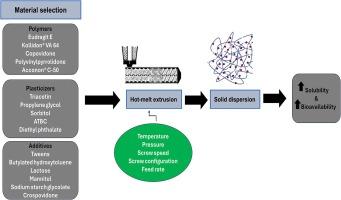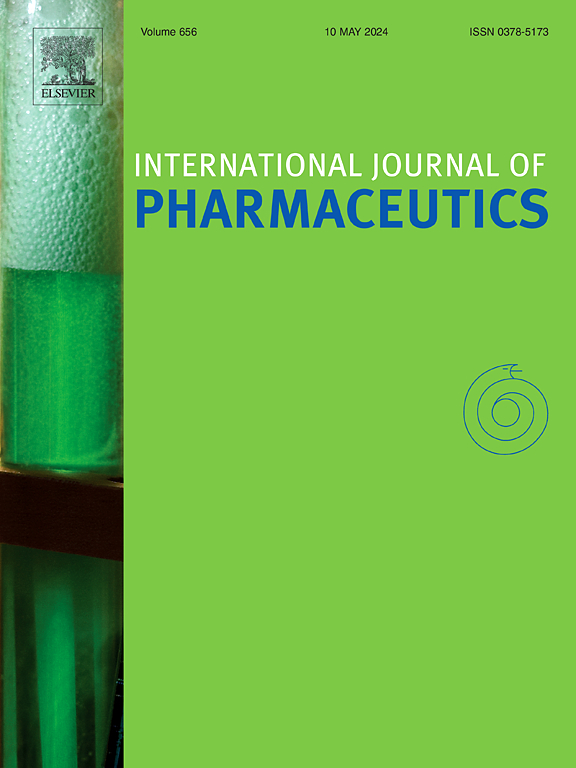Exploring the impact of material selection on the efficacy of hot-melt extrusion
IF 5.3
2区 医学
Q1 PHARMACOLOGY & PHARMACY
引用次数: 0
Abstract
Hot-melt extrusion (HME) has emerged as a versatile and efficient technique in pharmaceutical formulation development, particularly for enhancing the solubility and bioavailability of poorly water-soluble drugs. This review delves into the fundamental principles of HME, exploring its application in drug delivery systems. A comprehensive analysis of polymers utilized in HME, such as hydroxypropyl methylcellulose, ethyl cellulose, hydroxypropyl cellulose, and polyvinylpyrrolidone, is presented, highlighting their roles in achieving controlled drug release and improved stability. The incorporation of plasticizers, such as triacetin, poly(propylene glycol), glycerol, and sorbitol, is critical in reducing the glass transition temperature (Tg) of polymer blends, thereby enhancing the processability of HME formulations. A comparison of Tg values for various polymer-plasticizer combinations is discussed using different predictive models. For researchers and industry professionals looking to optimize drug formulation strategies, this article offers valuable insights into the mechanisms through which HME enhances drug solubility and bioavailability two critical factors in oral drug delivery. Furthermore, by reviewing recent patents and marketed formulations, the article serves as a comprehensive resource for understanding both the technical advancements and commercial applications of HME. Readers will gain a deep understanding of the role of polymers and additives in HME, alongside future perspectives on how emerging materials and techniques could further revolutionize pharmaceutical development. This review is essential for those aiming to stay at the forefront of pharmaceutical extrusion technologies and their potential to improve therapeutic outcomes. The review concludes that meticulous material selection is vital for advancing pharmaceutical manufacturing processes and ensuring optimal outcomes in HME applications, thereby enhancing the overall efficacy of drug delivery systems.

探索材料选择对热熔挤压效果的影响。
热熔挤出(HME)已成为药物制剂开发中一种多用途、高效率的技术,尤其适用于提高水溶性差的药物的溶解度和生物利用度。本综述深入探讨了 HME 的基本原理,并探讨了其在给药系统中的应用。文章全面分析了 HME 中使用的聚合物,如羟丙基甲基纤维素 (HPMC)、乙基纤维素、羟丙基纤维素 (HPC) 和聚乙烯吡咯烷酮 (PVP),重点介绍了它们在实现药物控释和提高稳定性方面的作用。三醋精、聚丙二醇、甘油和山梨醇等增塑剂的加入对于降低聚合物混合物的玻璃化转变温度(Tg)至关重要,从而提高 HME 配方的加工性能。本文使用不同的预测模型对各种聚合物-增塑剂组合的 Tg 值进行了比较。对于希望优化药物制剂策略的研究人员和业内专业人士来说,这篇文章为他们提供了宝贵的见解,让他们了解 HME 提高药物溶解度和生物利用度的机制,而这正是口服给药的两个关键因素。此外,通过回顾最近的专利和上市配方,文章还为了解 HME 的技术进步和商业应用提供了全面的资源。读者将深入了解聚合物和添加剂在 HME 中的作用,以及新兴材料和技术如何进一步革新药物开发的未来前景。这本综述对于那些希望在制药挤压技术及其改善治疗效果的潜力方面保持领先地位的人来说至关重要。本综述的结论是,精心选择材料对于推进制药工艺和确保 HME 应用的最佳结果至关重要,从而提高给药系统的整体疗效。
本文章由计算机程序翻译,如有差异,请以英文原文为准。
求助全文
约1分钟内获得全文
求助全文
来源期刊
CiteScore
10.70
自引率
8.60%
发文量
951
审稿时长
72 days
期刊介绍:
The International Journal of Pharmaceutics is the third most cited journal in the "Pharmacy & Pharmacology" category out of 366 journals, being the true home for pharmaceutical scientists concerned with the physical, chemical and biological properties of devices and delivery systems for drugs, vaccines and biologicals, including their design, manufacture and evaluation. This includes evaluation of the properties of drugs, excipients such as surfactants and polymers and novel materials. The journal has special sections on pharmaceutical nanotechnology and personalized medicines, and publishes research papers, reviews, commentaries and letters to the editor as well as special issues.

 求助内容:
求助内容: 应助结果提醒方式:
应助结果提醒方式:


